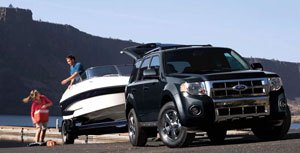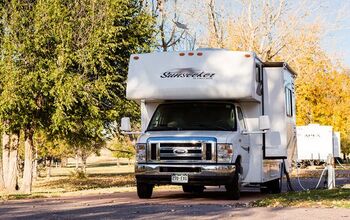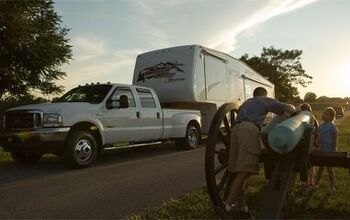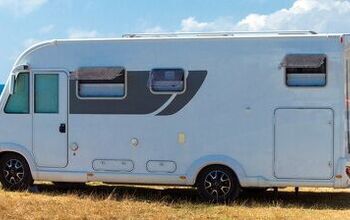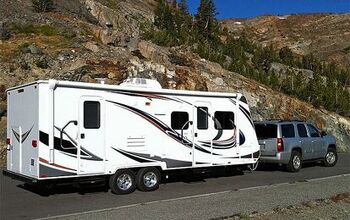How to Pick the Right Tow Vehicle
Choosing a vehicle for towing a trailer can seem like a daunting task. There may be many candidates to choose from, but knowing which to say “no” to can be confusing amidst all the marketing claims floating out there, not to mention Internet-based hearsay, gossip, and personal opinions. So where do you start?
Since you intend to tow, it is important to understand that your first step is to objectively select the right tool for the job – that is, pick a truck that can safely and reliably handle the trailer you intend to pull.
Once you are sure a proposed new vehicle is suitable for the work you intend to make it do, then you can also realistically assess how you plan to use it and what design, safety, aesthetic and creature comfort features are most important to you.
While you are self-assessing these priorities, ask yourself whether your towing will be infrequent, regular or full time? Will you also use the vehicle for work, or daily driving? How many people do you need to comfortably carry? Do you place a premium on luxury, or would a plainer model suffice?
The number of actual vehicles you may need to sort through is limited by the weight of the trailer you wish to tow. If all you plan to pull is a 3,000 to 4,000 pound popup camper, you have dozens of possibilities. If the trailer weighs 4,000 to 9,000 pounds, choices become fewer – usually full size trucks, vans or SUVs. And when contemplating 9,000 to 20,000 pounds or more, you are far more likely to become a customer of the American Big Three – Ford, Chevy/GMC or Dodge, although Toyota or Nissan have full-size trucks suitable for the lower end of this scale.
First things firstWhether or not the vehicle you’re looking at is even in the ballpark depends on its Gross Vehicle Weight Rating (GVWR), Gross Axle Weight Rating (GAWR), Maximum Trailer Tongue weight capacity, and tow ratings, as explained following.
Note: Advertised maximum tow ratings are usually unrealistic. They are based on a 150-pound driver at the wheel, a half tank of fuel and no cargo or passengers. What’s more, a theoretical vehicle marketers use to base their claims may not be spec’d the same as the one you are considering, which would further prevent you from hitting their number. And even if a salesman tells you vehicle X can handle a particular trailer no problem, you should take the time to independently verify this, while anticipating how you plan to really load it.
Curb Weight – Includes the weight of all fuel and other fluid weights. It does not include people or cargo, just the vehicle otherwise ready to go.
Tongue Weight or King Pin Weight – Also called Tongue Load; it’s the weight of the trailer pushed down on the hitch. A “king pin” applies to fifth wheel hitching. This is another critical weight limit you will want to know. Your tow vehicle can only handle so much, and you should not over-stress it.
Cargo Weight – Refers to the actual weight of all items added to the Curb Weight of the vehicle, including optional equipment, Tongue Weight or King Pin Weight, plus what ever else you pile on – food, drink, clothing, electronic equipment, kids’ toys, bicycles, motorcycles, ATVs, books, magazines, other gear, etc.
Gross Vehicle Weight (GVW) – A critical capacity to understand. It includes the Curb Weight, Cargo Weight, and weight of all people on board. The GVW is the whole enchilada – while it can be estimated, the only way to know it accurately is to put the vehicle on a public scale.
Gross Vehicle Weight Rating (GVWR) – Think of this as a “redline” you don’t want to push. It is the maximum weight you can carry, and includes the actual weight of the vehicle plus everything on it including the trailer’s tongue or kingpin weight.
Gross Axle Weight Rating (GAWR) – The most weight an axle should be subjected to and includes the weight of the tires, wheels, brakes and axle itself. If referring to the rear or front axle, it could be called RGAWR or FGAWR respectively.
Maximum Tow Rating – Set by the manufacturer; a recommended maximum weight of towed loads. For trailers using weight-carrying hitches, this typically includes a hitch-weight limit as well; for fifth-wheel trailers, the king pin weight is applied to the truck’s GVWR and RGAWR.
Gross Combination Weight Rating (GCWR) – Calculated by adding the maximum allowable GVW of both the tow vehicle and trailer (Gross Trailer Weight (GTW). It’s the maximum allowable weight for the tow vehicle plus trailer.
Go or no-go?The above weight stats are used to calculate how heavy a trailer you can tow.
The GVWR and GAWR are listed on the data plate, typically on the driver’s doorframe, fuel door, glove box, or end of the dashboard.
When contemplating whether you can pull a trailer safely and reliably, you need to know the trailer’s GVWR, and assume you will max it, as most people tend to.
Assuming that the tow vehicle’s axle weight is below the GAWR, the total is below the tow vehicle’s GVWR and the hitch or kingpin weight is below the manufacturer’s limit for your vehicle, you should be able to tow a given trailer.
So, for example, if your 2009 half ton GMC Sierra 1500 is rated to tow 4,800 pounds, you could try to take it to the limit, but it would be a lot happier if you only made it pull 20 percent less or around 3,850 pounds. You’d also have a greater safety and control margin built in. Does using a larger vehicle take more fuel? Yes. But what is it worth to you to put less stress on critical components that will be less likely to fail far from home?
A few heavyweight contendersAmerica’s Big Three have been building heavy-duty pickup trucks for decades, and unless Toyota renews now-halted plans for an up-rated version of its Tundra, they remain the only game in town for max-size towing.
Traditional terms for this class of trucks are “three quarter ton,” and “one-ton” – referring to their hauling capacity – but the actual capacities of today’s heavy duty pickups are typically much higher than their nominal monikers suggest.
Upgrades over a “half-ton” truck include sturdier chassis, suspension, brakes, drive train, cooling system, and more. Full floating rear axles handle far more weight, with double the number of load-handling tapered bearings.
Highway fuel mileage may (or in some cases, may not) be lower by a few miles per gallon than for half-ton trucks, but substantially higher towing capacity is a more than fair tradeoff. Ride quality may be somewhat stiffer, but here too great strides have been made toward offering day-to-day comfort, convenience and even luxury features never imagined in the days of your father’s or grandfather’s three-quarter ton.
Depending on options, realistic MSRP ranges from $39,000 to $59,000, with middle to high 40s being average.
These trucks can be configured in a variety of ways, which affect their ultimate cargo and people hauling capabilities, tow rating, as well as fuel mileage.
One of these variables is choice of single and dual rear wheels – duallies improve braking and add stability while towing, usually handle greater loads (though not necessarily) and they also add weight. Another factor affecting hauling ability is whether you opt for two or four-wheel drive – 4WD adds weight, decreasing GVWR. Likewise choice of regular, extended and crew-style cabs help determine maximum workload capabilities – larger cabs also add weight and cut into GVWR.
Note: Proprietary names for small, medium and large cab styles vary from manufacturer to manufacturer.
Another factor is whether you choose automatic or manual transmission – A manual (if available) typically reduces tow rating, and automatics are more commonly spec’d in these trucks. Further, automatics with lock-up torque converters negate traditional advantages of manual transmissions, which in gasoline engines include engine braking on hills.
And yet another critical option that changes everything for a given truck is whether or not to go with a diesel engine option. These cost more, and can add 700 or more pounds to a vehicle’s curb weight, yet ultimately contribute to higher tow ratings. All three makers offer brute strength variations that produce around 350-horsepower, and 650 lb-ft of torque – a measure of towing ability – at real world engine speeds.
The Ford diesel’s torque peak arrives at 2,000 rpm. Both the Dodge and Chevy diesels achieve it at a veritable walking pace of 1,500 and 1,600 rpm respectively – delivering about 40-percent more grunt at just one-third the engine speed required for maximum torque from a comparable displacement gasoline engine.
Note: We can’t name names, but be advised that in this competitive and profitable market certain truck manufacturers have been known to increase their various critical weight handling ratings by hundreds of pounds for a new model year without doing anything to the truck to make it stronger – such as increasing spring rates, or braking ability, or chassis strength. Sundling derisively chalks this phenomenon up to truck manufacturers sprinkling “Magic Spring Dust,” adding it is like “something Tinkerbell would give Peter Pan.” He has documented this practice several times as different truck marketers play one-upmanship against one another. This is one more reason to choose a truck rated for 20 percent more than your actual anticipated maximum trailer weight.
Chevrolet Silverado 2500HD/3500HDNote: These General Motors pickups are matched by the GMC clone line of Sierra 2500HD/3500HD.
Although fresh out of bankruptcy proceedings, with an assist by the Obama administration, Chevrolet nevertheless knows how to put together a fine truck.
These offer a tad bit lighter weight and capacity than the heaviest-duty Dodge or Ford models, but can be quite comfortable and well appointed, while still offering light commercial grade towing and serious load hauling capabilities.
For either the 2500HD or 3500HD, power comes from a 6.0-liter gasoline-powered Vortec V-8, or a 6.6-liter Duramax V-8 turbo diesel.
The Vortec line has been around since the early 1990s, having started life as a 4.3-liter six cylinder, and now available in many displacements and configurations in the GM line.
The turbo diesel was the result of a joint venture between GM and Isuzu. It is put together in Ohio, well over a million have been produced, and it has a fairly solid reputation.
Power for the gasoline engine equipped in models with a GVWR less than 10,000 pounds is 360 horsepower (268 kW) at 5,400 rpm. For models with GVWR exceeding 10,000 pounds, the gasoline engine is rated at 322 horsepower at 4,400 rpm.
Torque for the gasoline engine for all 2500HD/3500HD trucks is 380 lb-ft (515 Nm) at 4,200 rpm.
The Duramax diesel provides 365 horsepower (272 kW) at 3,200 rpm, and torque is 660 lb-ft (895 Nm) at 1,600 rpm.
Both gas and diesel versions come with a six-speed automatic transmission – the gas engine’s being a Hydra-Matic 6L90, and the diesel’s a commercial-grade Allison 1000.
The 2500HD’s GVWR is 9,200 pounds across the line, regardless of cab style, box length, or whether it has two or four wheel drive.
Towing capacity for the 2500HD is narrowly defined between 12,100 to 13,000 pounds, regardless of the above variables, engine style or axle ratio.
For the 3500HD – which like the larger Dodge and Ford models may come with or without dual rear wheels – GVWR ranges from 9,700 to 11,400 pounds. Tow ratings for the 3500HD range from 11,600 to 13,000 pounds.
ABS braking for both the 2500HD and 3500HD is handled by 12.8-inch rotors front and rear. The front rotors are 1.5 inches thick, while the rear rotors are 1.2 inches thick.
For more info, click here.
2010 Dodge Ram 2500/3500Engine choices for this popular truck line are either a gasoline-powered 5.7-liter V-8 Hemi, or 6.7-liter inline-six Cummins turbo diesel. The Hemi is rated at 383 horsepower (286 kW) at 5,600 rpm and 400 lb-ft of torque (542 Nm) at 4,000 rpm. The overachieving Cummins makes 350 horsepower (261 kW) at 3,000 rpm and 650 lb-ft of torque (881 Nm) at 1,500 rpm.
The gas engine is powerful, and if you’re not looking to pull the absolute highest trailer weights, it is an able workhorse, especially when mated to the 4.10:1 rear axle ratio.
The optional diesel however, is arguably the Ram’s brightest shining attribute. The Cummins 6.7-liter ISB I-6 has a strong reputation. Cummins is an American manufacturer with a long history of producing very durable commercial and industrial diesels, and this engine has a loyal following of raving fans. If you want a testimony from a competitor, consider that Ford offers a Cummins 6.7-liter engine (mated with a suitable transmission) in its 2009 F-650/F-750 commercial trucks, which have GVWRs from 20,000 to 37,000 pounds.
The Ram 2500/3500 series pickup trucks equipped with Hemi engines come with a five-speed automatic transmission, and diesel-equipped models come with a six-speed automatic and can be equipped with a six-speed manual.
Historically some Dodge Cummins-engine trucks have been mated to an automatic transmission that did not share its stellar credentials, although Dodge currently offers a robust warranty and claims fixes for durability should remove any further concern.
Note: If tempted to look at the used market, look for technical service bulletins (TSBs) on this truck for any known issues. The aftermarket may also have solutions to substantially improve reliability gaps left by Dodge.
Aside from engines offering more go-power than ever, Ram 2500/3500 trucks offer massive stopping power from ABS-equipped 13.9 inch brake rotors front and rear.
Chassis and suspension ratings now offer a peak Gross Combined Weight Rating (GCWR) of 25,400 pounds for the Ram 3500 with dual-rear wheels, diesel engine, automatic transmission and 4.10:1 rear axle. This configuration is also theoretically capable of towing 18,500 pounds or hauling a maximum payload of 5,110 pounds.
For more info, click here.
2010 Ford F-Super Duty SeriesFord leads the market in sales, and has built a reputation for trucks that do everything well. The 2010 F-Super Duty series is made up of 17 different models, each of which can be further tailored with a variety of options.
While the F-250, F-350 and F-450 are big brothers to America’s top-selling full-size pickup, the F-150, Ford says the F-Super Duty series are built tougher from the ground up.
Engine choices – depending on model – range from a 5.4-liter gasoline-powered Triton V-8, a 6.8-liter gasoline-powered Triton V-10, and a 6.4-liter Power Stroke V-8 Turbo Diesel.
The 5.4-liter V-8 gasoline engine produces 300 horsepower (224 kW) at 5,000 rpm, and 365 lb-ft (494 Nm) of torque at 3,750 rpm. The 6.8-liter V-10 gasoline engine produces 362 horsepower (270 kW) at 4,750 rpm, and 457 lb-ft (619 Nm) of torque at 3,250. The 6.4-liter Power Stroke diesel promises 350 horsepower (261 kW) at 2,000 rpm (or 325 horsepower (242 kW) at 2,000 rpm for F-450), and 650 lb-ft (880 Nm) of torque at 2,000 rpm (or 600 lb-ft (813 Nm) at 2,000 rpm for F-450).
Transmission options are a five-speed TorqShift automatic with overdrive, or a six-speed manual.
After this year, Ford will switch to a new diesel. Following a legal battle involving mutual finger pointing, Ford announced early this year that it will end its use of International’s Navistar division-made engines in North America as of Dec. 31, 2009.
According to Sundling, the short story the falling out can be traced to Ford’s “bean counters,” which were largely at fault for rampant warranty claims against Ford’s 6.0-liter Power Stroke (Navistar) engines from 2003-2007. Sundling says these engines had worked fine in International trucks, but were plagued in Fords because the company cheapened proprietary engine controls to try and save on production costs.
The Navistar’s replacement is a Ford designed and built 2011 F-Series 6.7-liter diesel engine that was introduced Sept. 24 at the Texas State Fair. Additionally for 2011, Ford will offer a new 6.2-liter gasoline-powered V-8.
The diesel promises a number of innovative features and undoubtedly has the 6.7-liter Dodge Cummins engine in its crosshairs. Our sister publication AutoGuide gave its initial impressions here. [http://www.autoguide.com/auto-news/2009/09/report-2011-ford-f-series-super-duty-officially-debuts-at-texas-state-fair.html].
Note: Looking for TSBs when thinking of buying used is recommended.
Despite some problems, many F-Super Duty models have had no major issues, and Ford has managed to hold a sizable base of loyal consumer and commercial customers, which means they must be doing a lot of other things very well.
Some of the things Ford does well include leading the market in towing capabilities. F-Series Super Duty trucks are rated to tow from 16,000 to 24,500 pounds (when mated with a fifth wheel trailer). The lightest-duty 2010 F-250 has a GVWR of 8,800 pounds, and the heaviest-duty F-450 offers a GVWR of 14,500 pounds, with F-350s offering capacity between these two extremes.
Axle (GAWR) ratings are as follows: F-250, 6,200 pounds, F-350 (single rear wheel), 7,280 pounds, F-350, (dual rear wheel), 9,000 pounds, F-450: 11,000 pounds.
Ford also offers an integrated Tow Command System, which works with a “special trailer-brake strategy” when the antilock braking system detects poor traction.
And those ABS brakes also happen to be the largest offered by the Big Three manufacturers. The F-250s and F-350s come with brakes boasting 13.66-inch front rotors, and 13.39-inch rear rotors. The F-450 boasts massive 14.53-inch front and 15.35-inch rear rotors demonstrating a serious commitment to towing applications.
For more info, click here.
So which is the best vehicle for towing?When it comes to lighter trailers, there are potentially dozens of choices that we’d need to highlight. While we could arbitrarily pick a “top 10” list, it would favor our biases, without regard for your individual needs and wants.
Assuming you follow our guide to picking one able to handle your heaviest loads with a 20-percent safety cushion built in, while also researching a given vehicle’s reliability record, as trite as it sounds, the “best” is otherwise the one that works best for you – your tastes and bank account.
As for the Big Three heavy-duty pickup lines highlighted, the same goes: No one can agree who makes the best. Some writers have tried to name a “best,” while others have disagreed. Marketers for each brand argue theirs is obviously the best, but you’d expect that. And don’t look for universal agreement among the many biased or even not-so-biased fans – or critics – of these brands.
So we did not even try to pick one, again, because too many details involve personal opinions and unique needs and wants. Instead, we gave you qualified vehicles, and told you a few key things to look for – and look out for.
And as things stand, these American trucks are the best they’ve ever been, with no import competition to date. On the other hand, each has an Achilles’ heel here and there among various configurations and model years leading to this one.
But this not withstanding, the Big Three are highly committed to this remaining bastion of American automotive superiority and profitability.
For more information, write-ups on individual models can be read on AutoGuide.com.

